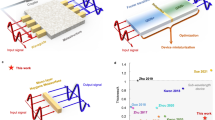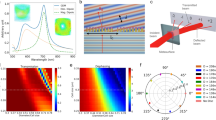Abstract
As standard microelectronic technology approaches fundamental limitations in speed and power consumption, novel computing strategies are strongly needed. Analogue optical computing enables the processing of large amounts of data at a negligible energy cost and high speeds. Based on these principles, ultrathin optical metasurfaces have been recently explored to process large images in real time, in particular for edge detection. By incorporating feedback, it has also recently been shown that metamaterials can be tailored to solve complex mathematical problems in the analogue domain, although these efforts have so far been limited to guided-wave systems and bulky set-ups. Here, we present an ultrathin Si metasurface-based platform for analogue computing that is able to solve Fredholm integral equations of the second kind using free-space visible radiation. A Si-based metagrating was inverse-designed to implement the scattering matrix synthesizing a prescribed kernel corresponding to the mathematical problem of interest. Next, a semitransparent mirror was incorporated into the sample to provide adequate feedback and thus perform the required Neumann series, solving the corresponding equation in the analogue domain at the speed of light. Visible wavelength operation enables a highly compact, ultrathin device that can be interrogated from free space, implying high processing speeds and the possibility of on-chip integration.
This is a preview of subscription content, access via your institution
Access options
Access Nature and 54 other Nature Portfolio journals
Get Nature+, our best-value online-access subscription
$29.99 / 30 days
cancel any time
Subscribe to this journal
Receive 12 print issues and online access
$259.00 per year
only $21.58 per issue
Buy this article
- Purchase on Springer Link
- Instant access to full article PDF
Prices may be subject to local taxes which are calculated during checkout






Similar content being viewed by others
Data availability
The data that support the findings of this study are available from the corresponding author upon reasonable request.
Code availability
All codes produced during this research are available from the corresponding author upon reasonable request.
References
Athale, R. & Psaltis, D. Optical computing: past and future. Opt. Photon. News 27, 32–39 (2016).
Solli, D. R. & Jalali, B. Analog optical computing. Nat. Photon. 9, 704–706 (2015).
Zangeneh-Nejad, F., Sounas, D. L., Alù, A. & Fleury, R. Analogue computing with metamaterials. Nat. Rev. Mater. 6, 207–225, (2020).
Silva, A. et al. Performing mathematical operations with metamaterials. Science 343, 160–163 (2014).
Zhu, T. et al. Plasmonic computing of spatial differentiation. Nat. Commun. 8, 15391 (2017).
Zhu, T. et al. Generalized spatial differentiation from the spin Hall effect of light and its application in image processing of edge detection. Phys. Rev. Appl. 11, 034043 (2019).
Zhu, T. et al. Topological optical differentiator. Nat. Commun. 12, 680 (2021).
Guo, C., Xiao, M., Minkov, M., Shi, Y. & Fan, S. Photonic crystal slab Laplace operator for image differentiation. Optica 5, 251–256 (2018).
Guo, C., Xiao, M., Minkov, M., Fan, S. & Shi, Y. Isotropic wavevector domain image filters by a photonic crystal slab device. J. Opt. Soc. Am. A 35, 1685–1691 (2018).
Wang, H., Guo, C., Zhao, Z. & Fan, S. Compact incoherent image differentiation with nanophotonic structures. ACS Photon. 7, 338–343 (2020).
Kwon, H., Sounas, D., Cordaro, A., Polman, A. & Alù, A. Nonlocal metasurfaces for optical signal processing. Phys. Rev. Lett. 121, 173004 (2018).
Cordaro, A. et al. High-index dielectric metasurfaces performing mathematical operations. Nano Lett. 19, 8418–8423 (2019).
Youssefi, A., Zangeneh-Nejad, F., Abdollahramezani, S. & Khavasi, A. Analog computing by Brewster effect. Opt. Lett. 41, 3467–3470 (2016).
Momeni, A., Rajabalipanah, H., Abdolali, A. & Achouri, K. Generalized optical signal processing based on multioperator metasurfaces synthesized by susceptibility tensors. Phys. Rev. Appl. 11, 064042 (2019).
Abdollahramezani, S., Hemmatyar, O. & Adibi, A. Meta-optics for spatial optical analog computing. Nanophotonics 9, 4075–4095 (2020).
Moeini, M. M. & Sounas, D. L. Discrete space optical signal processing. Optica 7, 1325–1331 (2020).
Zhou, Y., Zheng, H., Kravchenko, I. I. & Valentine, J. Flat optics for image differentiation. Nat. Photon. 14, 316–323 (2020).
Pors, A., Nielsen, M. G. & Bozhevolnyi, S. I. Analog computing using reflective plasmonic metasurfaces. Nano Lett. 15, 791–797 (2015).
Bykov, D. A. et al. First-order optical spatial differentiator based on a guided-mode resonant grating. Opt. Express 26, 10997–11006 (2018).
Kwon, H., Cordaro, A., Sounas, D., Polman, A. & Alù, A. Dual-polarization analog 2D image processing with nonlocal metasurfaces. ACS Photon. 7, 1799–1805 (2020).
Bogaerts, W. et al. Programmable photonic circuits. Nature 586, 207–216 (2020).
Shen, Y. et al. Deep learning with coherent nanophotonic circuits. Nat. Photon. 11, 441–446 (2017).
Shastri, B. J. et al. Photonics for artificial intelligence and neuromorphic computing. Nat. Photon. 15, 102–114 (2021).
van de Burgt, Y. et al. A non-volatile organic electrochemical device as a low-voltage artificial synapse for neuromorphic computing. Nat. Mater. 16, 414–418 (2017).
Van De Burgt, Y., Melianas, A., Keene, S. T., Malliaras, G. & Salleo, A. Organic electronics for neuromorphic computing. Nat. Electron. 1, 386–397 (2018).
Zangeneh-Nejad, F. & Fleury, R. Performing mathematical operations using high-index acoustic metamaterials. New J. Phys. 20, 073001 (2018).
Zangeneh-Nejad, F. & Fleury, R. Topological analog signal processing. Nat. Commun. 10, 2058 (2019).
Hughes, T. W., Williamson, I. A. D., Minkov, M. & Fan, S. Wave physics as an analog recurrent neural network. Sci. Adv. 5, eaay6946 (2019).
Mohammadi Estakhri, N., Edwards, B. & Engheta, N. Inverse-designed metastructures that solve equations. Science 363, 1333–1338 (2019).
Camacho, M., Edwards, B. & Engheta, N. A single inverse-designed photonic structure that performs parallel computing. Nat. Commun. 12, 1466 (2021).
Arfken, G. B., Weber, H. J. & Harris, F. E. Mathematical Methods for Physicists (Elsevier, 2013).
Oldenburger, R. Infinite powers of matrices and characteristic roots. Duke Math. J. 6, 357–361 (1940).
Molesky, S. et al. Inverse design in nanophotonics. Nat. Photon. 12, 659–670 (2018).
Piggott, A. Y. et al. Inverse design and demonstration of a compact and broadband on-chip wavelength demultiplexer. Nat. Photon. 9, 374–377 (2015).
Sell, D., Yang, J., Doshay, S., Yang, R. & Fan, J. A. Large-angle, multifunctional metagratings based on freeform multimode geometries. Nano Lett. 17, 3752–3757 (2017).
Lalau-Keraly, C. M., Bhargava, S., Miller, O. D. & Yablonovitch, E. Adjoint shape optimization applied to electromagnetic design. Opt. Express 21, 21693 (2013).
Hughes, T. W., Minkov, M., Williamson, I. A. D. & Fan, S. Adjoint method and inverse design for nonlinear nanophotonic devices. ACS Photon. 5, 4781–4787 (2018).
Green, M. A. Self-consistent optical parameters of intrinsic silicon at 300 K including temperature coefficients. Sol. Energy Mater. Sol. Cells 92, 1305–1310 (2008).
Kelly, R. L. Program of the 1972 Annual Meeting of the Optical Society of America. J. Opt. Soc. Am. 62, 1336 (1972).
Malitson, I. H. Interspecimen comparison of the refractive index of fused silica. J. Opt. Soc. Am. 55, 1205–1209 (1965).
Jiang, J. et al. Free-form diffractive metagrating design based on generative adversarial networks. ACS Nano 13, 8872–8878 (2019).
Goodman, J. W., Dias, A. R. & Woody, L. M. Fully parallel, high-speed incoherent optical method for performing discrete Fourier transforms. Opt. Lett. 2, 1–3 (1978).
Athale, R. A. & Collins, W. C. Optical matrix–matrix multiplier based on outer product decomposition. Appl. Opt. 21, 2089–2090 (1982).
Farhat, N. H., Psaltis, D., Prata, A. & Paek, E. Optical implementation of the Hopfield model. Appl. Opt. 24, 1469–1475 (1985).
Zhu, W., Zhang, L., Lu, Y., Zhou, P. & Yang, L. Design and experimental verification for optical module of optical vector–matrix multiplier. Appl. Opt. 52, 4412–4418 (2013).
Spall, J., Guo, X., Barrett, T. D. & Lvovsky, A. I. Fully reconfigurable coherent optical vector–matrix multiplication. Opt. Lett. 45, 5752–5755 (2020).
Rosenblatt, G., Simkhovich, B., Bartal, G. & Orenstein, M. Nonmodal plasmonics: controlling the forced optical response of nanostructures. Phys. Rev. X 10, 011071 (2020).
Li, L. Bremmer series, R-matrix propagation algorithm, and numerical modeling of diffraction gratings. J. Opt. Soc. Am. A 11, 2829–2836 (1994).
Sukham, J., Takayama, O., Lavrinenko, A. V. & Malureanu, R. High-quality ultrathin gold layers with an APTMS adhesion for optimal performance of surface plasmon polariton-based devices. ACS Appl. Mater. Interfaces 9, 25049–25056 (2017).
Verschuuren, M. A., Knight, M. W., Megens, M. & Polman, A. Nanoscale spatial limitations of large-area substrate conformal imprint lithography. Nanotechnology 30, 345301 (2019).
Lalanne, P., Hugonin, J. P. & Chavel, P. Optical properties of deep lamellar gratings: a coupled Bloch-mode insight. J. Light. Technol. 24, 2442–2449 (2006).
Acknowledgements
This work is part of the research programme of the Dutch Research Council (NWO) and is supported by the Air Force Office of Scientific Research’s Multidisciplinary Research Program of the University Research Initiative with grant no. FA9550-17-1-0002. V.N.’s effort is supported by the National Science Foundation Materials Research Science and Engineering Centers programme under award no. DMR-1720530.
Author information
Authors and Affiliations
Contributions
A.C. designed and fabricated the samples, performed the numerical simulations and performed the optical measurements. A.C., B.E. and V.N. performed the theoretical analyses. A.A., N.E. and A.P. supervised the project. All authors contributed to the analysis and writing of the paper.
Corresponding author
Ethics declarations
Competing interests
The authors declare no competing interests.
Peer review
Peer review information
Nature Nanotechnology thanks Arkaprovo Das, Xiaowen Dong and the other, anonymous, reviewer(s) for their contribution to the peer review of this work.
Additional information
Publisher’s note Springer Nature remains neutral with regard to jurisdictional claims in published maps and institutional affiliations.
Supplementary information
Supplementary Information
Supplementary Figs. 1–8 and Discussion.
Rights and permissions
Springer Nature or its licensor (e.g. a society or other partner) holds exclusive rights to this article under a publishing agreement with the author(s) or other rightsholder(s); author self-archiving of the accepted manuscript version of this article is solely governed by the terms of such publishing agreement and applicable law.
About this article
Cite this article
Cordaro, A., Edwards, B., Nikkhah, V. et al. Solving integral equations in free space with inverse-designed ultrathin optical metagratings. Nat. Nanotechnol. 18, 365–372 (2023). https://doi.org/10.1038/s41565-022-01297-9
Received:
Accepted:
Published:
Issue Date:
DOI: https://doi.org/10.1038/s41565-022-01297-9
This article is cited by
-
Diffractive optical computing in free space
Nature Communications (2024)
-
Inverse-designed low-index-contrast structures on a silicon photonics platform for vector–matrix multiplication
Nature Photonics (2024)
-
All-optical geometric image transformations enabled by ultrathin metasurfaces
Nature Communications (2023)
-
Dispersion engineered metasurfaces for broadband, high-NA, high-efficiency, dual-polarization analog image processing
Nature Communications (2023)



